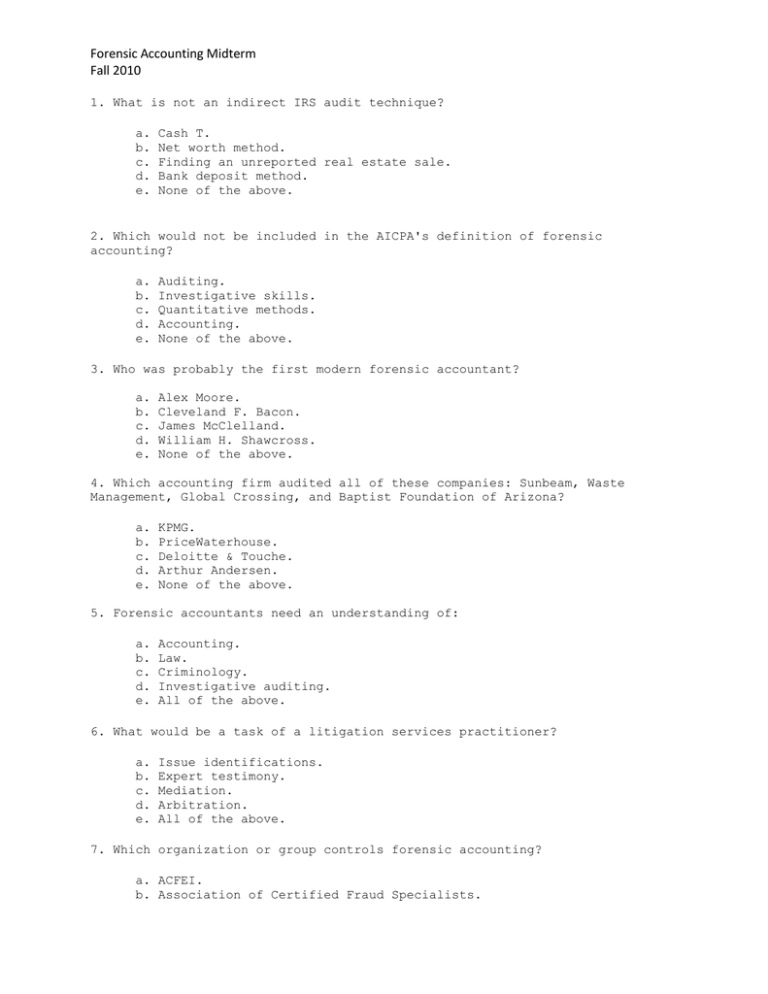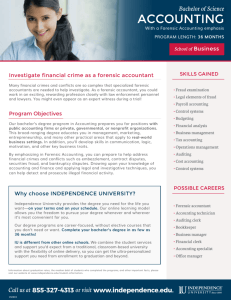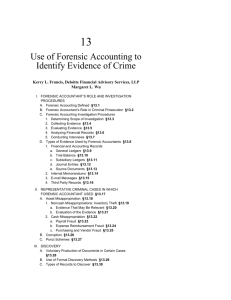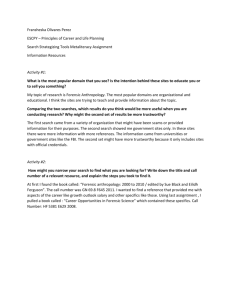if - Cal State LA - Instructional Web Server
advertisement

Forensic Accounting Midterm Fall 2010 1. What is not an indirect IRS audit technique? a. b. c. d. e. Cash T. Net worth method. Finding an unreported real estate sale. Bank deposit method. None of the above. 2. Which would not be included in the AICPA's definition of forensic accounting? a. b. c. d. e. Auditing. Investigative skills. Quantitative methods. Accounting. None of the above. 3. Who was probably the first modern forensic accountant? a. b. c. d. e. Alex Moore. Cleveland F. Bacon. James McClelland. William H. Shawcross. None of the above. 4. Which accounting firm audited all of these companies: Sunbeam, Waste Management, Global Crossing, and Baptist Foundation of Arizona? a. b. c. d. e. KPMG. PriceWaterhouse. Deloitte & Touche. Arthur Andersen. None of the above. 5. Forensic accountants need an understanding of: a. b. c. d. e. Accounting. Law. Criminology. Investigative auditing. All of the above. 6. What would be a task of a litigation services practitioner? a. b. c. d. e. Issue identifications. Expert testimony. Mediation. Arbitration. All of the above. 7. Which organization or group controls forensic accounting? a. ACFEI. b. Association of Certified Fraud Specialists. Forensic Accounting Midterm Fall 2010 c. ACFE. d. NACVA. e. None of the above. 8. Which certificate is provided by the American College of Forensic Examiners? a. b. c. d. e. CFE. CFA. CFFA. Cr.FA. None of the above. 9. Which is not one of the three M's of financial statement fraud? a. b. c. d. e. Missing general ledger. Manipulation. Misrepresentation. Intentional misapplication. None of the above. 10. Which group is not one of the members of corporate governance in the sixlegged stool as outlined by Professor Zab Razaee? a. b. c. d. e. Board of Directors. Audit Committee. Internal auditors. Employees of the company. All of the above are one of the six groups. 11. Which quality or characteristic is not outlined in Statement of Financial Concepts No. 2? a. b. c. d. e. Relevance. Materiality. Timeliness. Transparency. All of the above is in the No. 2 statement. 12. Which would be an example of the bill-and-hold strategy? a. Books are kept open beyond the appropriate time. b. Sell products and hold them, with an agreement to bill customers later. c. Combine restricted fund account with the general fund account. d. Inflate revenues with phony software sales. e. None of the above. 13. Control risk is: a. A risk that a material error in the balance or transaction class will not be prevented or detected. b. The risk that an account or transactions contain material misstatements before the effects or the controls. Forensic Accounting Midterm Fall 2010 c. The measure of whether something is significant enough to change an investor's investment decision is a prime consideration in how the audit is conducted. d. The risk that audit procedures will not turn up material error when it exists. e. None of the above. 14. Which is not one of the factors in SAS No. 99's pyramid of fraud? a. b. c. d. e. Incentives. Pressures. Opportunities. Attitudes/rationalization. All of the above are SAS No. 99 factors. 15. Which statement is false? a. SAS No. 99 indicates that auditors must be skeptical. b. Skepticism is an attitude that includes a questioning mind and a critical assessment of audit evidence. c. SAS No. 99 instructs auditors to question management about possible fraud. d. Tests of controls by auditors are sufficient for auditors to catch fraud. e. None of the above. 16. Which statement is false regarding SAS No. 99? a. b. c. d. in e. SAS No. 99 places more emphasis on misappropriation of assets. SAS No. 82 was replaced by SAS No. 99. Three conditions are generally present when fraud occurs. Fraud is an intentional act that results in a material misstatement financial statements. None of the above. 17. Which statement is false? a. Accountants are perhaps the most valuable employee-fraud fighters. b. Fighting fraud calls for prevention as the first step and the preferred tactic. c. Government entities are generally not targets for fraudsters. d. Often misappropriation is accomplished by false or misleading records or documents. e. None of the above. 18. The most common method of detecting occupational fraud is: a. b. c. d. e. External auditors. Internal auditors. Accident. Tips. Some other method. Forensic Accounting Midterm Fall 2010 19. A company has a 22% profit margin and has employee fraud of $220,000. Calculate the additional revenue needed to offset this lost income. a. b. c. d. e. $540,000. $720,000. $820,000. $1,000,000. Some other amount. 20. You are told that a company has a 20% profit margin and the discovered fraud has caused $1,400,000 more needed revenue to cover the fraud. How much was stolen? a. b. c. d. e. $280,000. $560,000. $1,400,000. $7,000,000. Some other amount. 21. Which statement is false? a. A special agent of the IRS developed a strategy to help indict Al Capone. b. Probing missing income by pointing to specific items of income that do not appear on a tax return is an indirect method of reconstructing income. c. District attorneys may obtain tax returns. d. Tracing monies from a dummy corporation to an individual is a direct method of reconstructing income. e. None of the above is false. 22. Which statement is false? a. Al Capone was indicted on numerous counts of income tax evasion, convicted, and sentenced to 11 years in prison. b. The IRS used financial ledgers and bank statements to help convict Al Capone. c. Former Governor Edwin Edwards was able to use the cash hoard defense to avoid prison. d. IRS agents may use both direct and indirect methods to reconstruct taxable income. e. None of the above is false. 23. Which would not be a direct IRS method for reconstructing taxable income? a. b. c. d. e. Newspaper articles. Checking deed records of real estate transactions. Discussions with third parties. Checking public records. All of the above are direct methods. 24. Which statement is false? a. The CIA used financial lifestyle probes and audits to capture Aldrich Ames, a mole within the CIA. Forensic Accounting Midterm Fall 2010 b. A vacation home is an example of a lifestyle change relevant to fraud detection. c. A high living style may be obtained by going into debt. d. A forensic accountant is more like a bloodhound than a watchdog. e. None of the above. 25. Which statement is false? a. A non-testifying expert may fall under an attorney's work product privilege. b. An accountant may testify as a lay witness or an expert witness. c. Expert testimony is not needed to explain an issue or fact that an average person can understand. d. An expert witness may rely on inadmissible facts or data. e. None of the above is false. 26. Which statement is false? a. An expert witness may be asked to answer hypothetical questions only on deposition. b. Normally a non-expert witness can give an opinion. c. A forensic accountant should be hired directly by the attorney. d. Confidential communication between client and lawyer is considered a protective privilege. e. None of the above is false. 27. An expert would probably not be able to: a. Give an opinion that embraces an ultimate issue to be decided by the trier of facts. b. State that my opinion is based on a reasonable degree of scientific certainty. c. An expert testifies regarding his opinion without first testifying to the underlying facts or data. d. An expert bases his opinion on evidence not admissible in evidence if of a type reasonably relied upon by experts in the particular field. e. An expert can do all of the above. 28. Which is not one of the Daubert factors? a. Whether the theory existed before litigation began. b. Whether the theory or technique in question can be and has been tested. c. The theory's known or potential error rate. d. The theory has attracted widespread acceptance. e. All are Daubert factors. 29. See attached net worth problem






